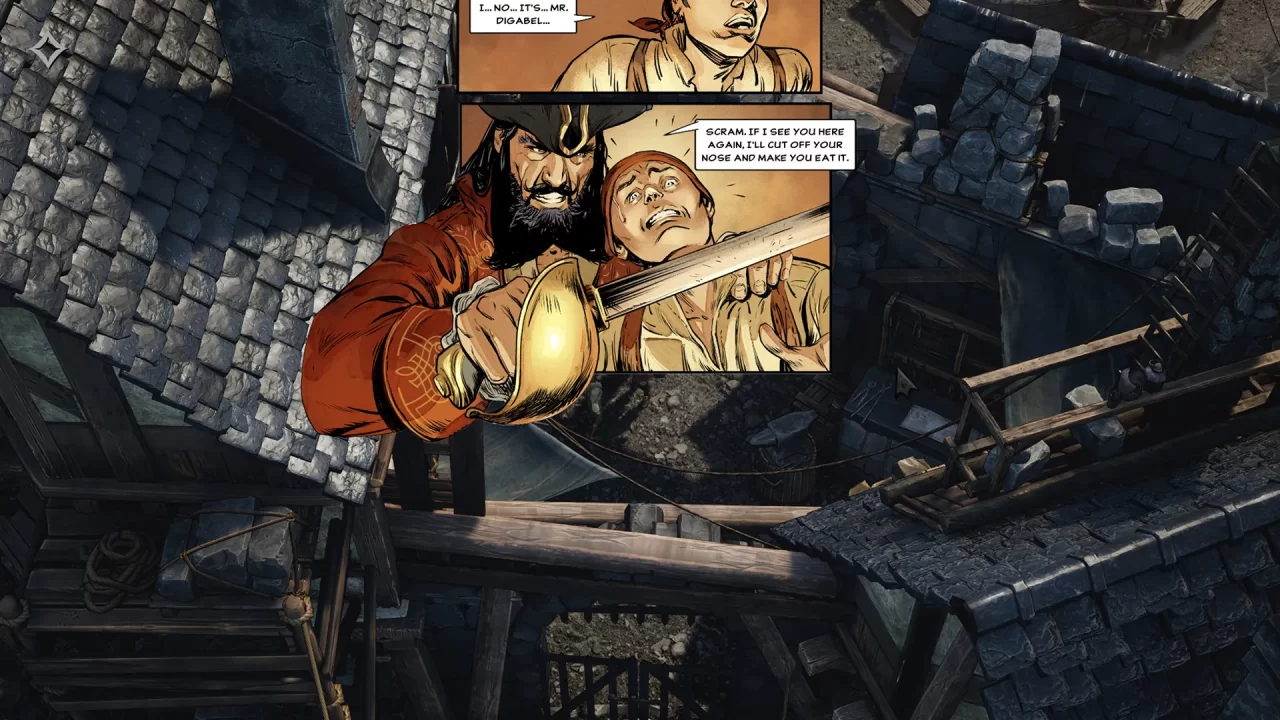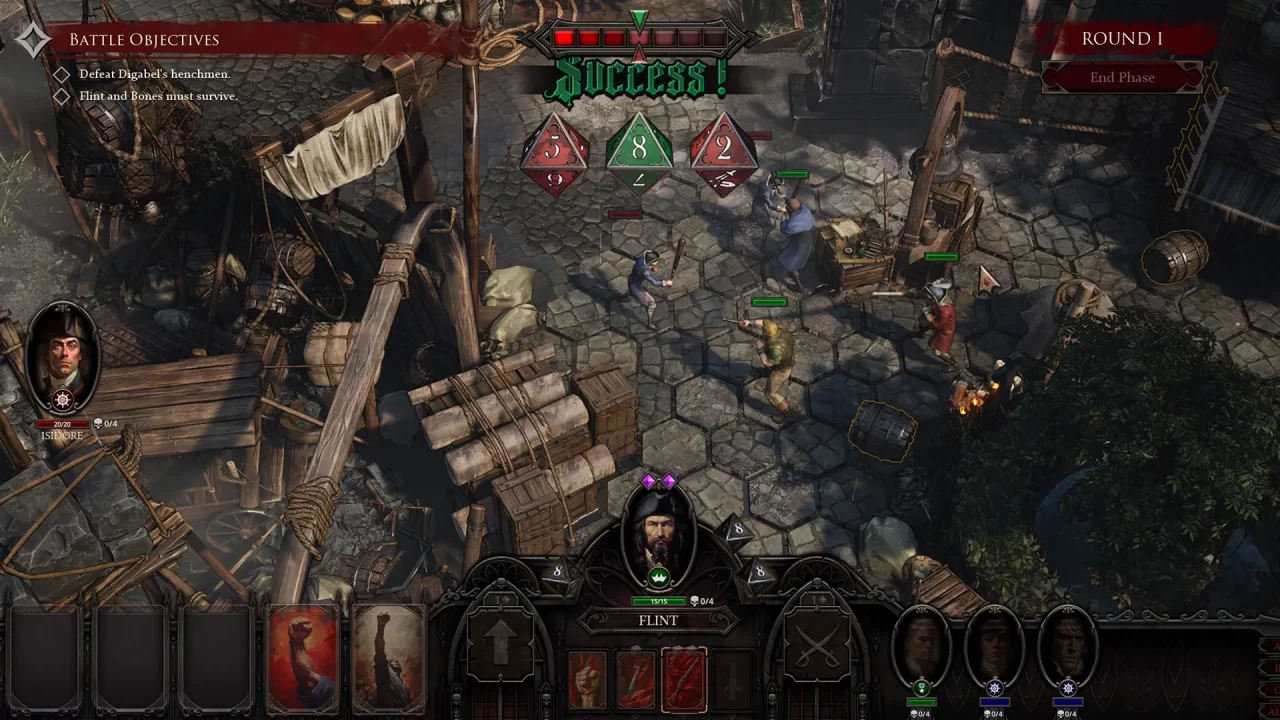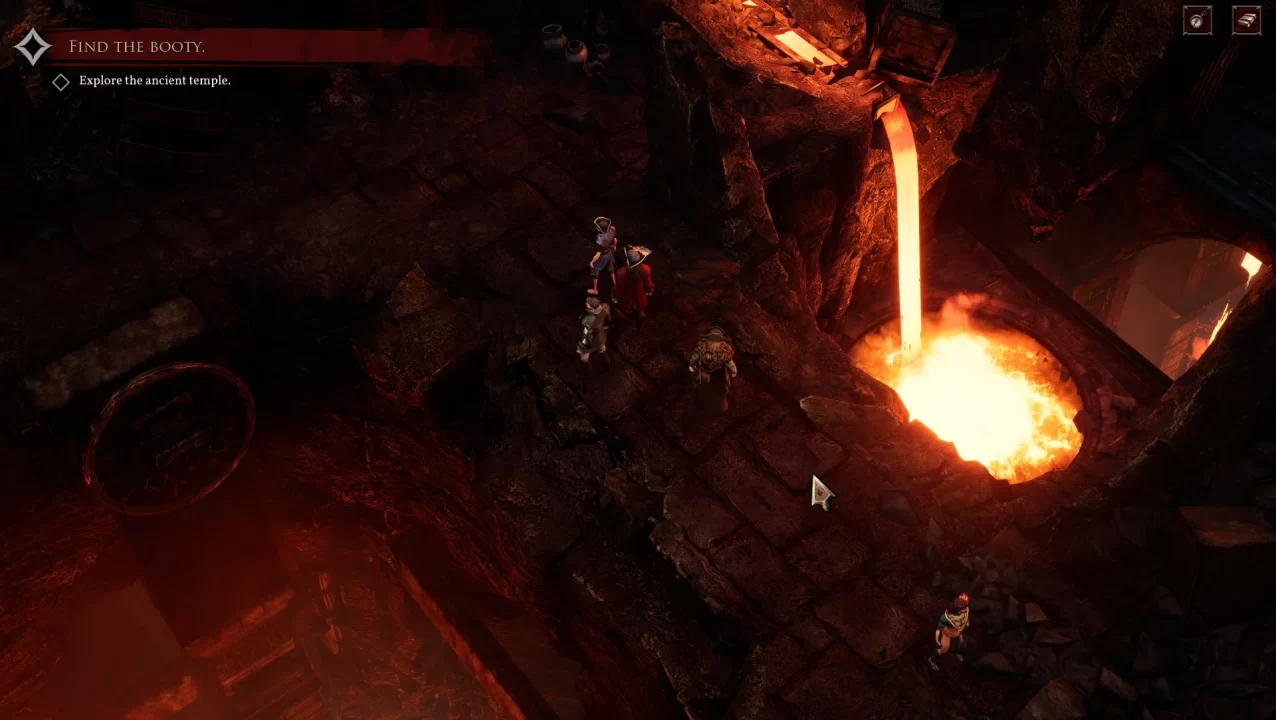Shiver your timbers and avast! Or some such piratical platitude, as Flint: Treasure of Oblivion (Flint: ToO) is here to deliver a nautical SRPG romp straight from the pages of a weekly adventure serial. Alongside some detailed comic art in the pulp narrative, there’s a beefy turn-based strategic layer to learn. However, the underlying systems are not explained or introduced well, and control can often be cumbersome and lack intuition. When coupled with an uneven difficulty, Savage Level‘s tropical adventure starts to lose its lustre slightly.
Narratively, Flint: Treasure of Oblivion is a simple tale of pirates and treasure. Captain Flint and his best mate, Billy Bones, are locked up in a French island fort. It’s only through Flint’s sharp intellect and a series of encounters and challenges that they escape into the island town of Saint-Malo and begin their life of adventure chasing after a rumored treasure. Along the way, Flint collects crew members with varied backstories and reasons for joining, often cleverly manipulated by Flint, whose ability to turn situations to his advantage makes him a protagonist to root for, alongside his pithy putdowns and one-liners. Flint:ToO checks most piratical boxes, with mutinies, strange island cultures, and Spanish and English sea dogs all present and accounted for. The game presents most of the story through static comic strips, and the artwork is eye-catching and professionally illustrated. They capture Flint’s irascible yet clever quality, and the illustrations for the various moments of drama and combat are framed well and don’t hold back in depicting the violence and intensity of the historical period.

The camera operates above Flint during exploration and stays fixed, although you can rotate it during combat. The setting details, built in Unity, are evocative of the era. The shanty town at the base of the fortress is full of beat-up shacks and desperate folk, while tropical islands have a good range of foliage scenery and forgotten stone temples. The more mystical elements of the story allow the engine and artists to have more fun with otherworldly planes and effects. Having said that, most of the characters and places Flint visits are straight out of Treasure Island and the commercial mythos established from 18th-century piratical culture.
Combat scenarios occur at regular intervals as the party explores. Flint and his growing band of piratical associates take part in squad-sized combat on small maps. Each character begins with two action points to spend on either movement or action, although reloading larger guns takes longer. There’s no turn order; characters can act and move in whatever order desired. There are no random encounters or layouts, and all the combat scenarios test different aspects of the player’s strategic approach.
Terrain actions are key to these approaches, with characters able to push barrels to knock foes over or jump from great heights to kill them outright. Each pirate has access to a profession and weapon choices, which provide the essential core of their abilities and strengths. Some are hardier thugs who find it easier to take and dish damage; others are more dexterous, suited for muskets and other firearms. Although there are few combat abilities, each weapon has a different status effect and range/attack areas. This makes for clever combinations and considerations. You could arm your entire squad with powerful firearms, but the time it takes to reload them may prove an issue if the enemy closes in. Conversely, using weapons with a wide attack range can be devastating, but tight maps mean allies could be in attack range, too. Is it worth it to take down an enemy?

Combat resolves through on-screen dice rolls, and each character, their level, and their weapon all affect the type of die used, from d4 to d12. A critical fail results in weapons breaking, but critical hits improve your squad morale. A further dice roll determines if a weapon inflicts a status effect, like causing an enemy to go dizzy and miss a turn. It’s cool to see just how important these effects are in Flint: characters don’t have tons of health, so a bleed or a missed turn has a massive impact on swinging the odds one way or another. It makes selecting the weapon with the status effects you want all the more important.
Alongside all of this, there are items to consider, including rare healing bandages and grenades of different types. These can be crafted during downtime between encounters with enough coin, and understanding how to use them in any given encounter is essential. For example, a basic grenade deals a tremendous amount of damage in an area after a short delay, making it an essential item in any scenario where getting the enemy to clump together is a key tactic.
Items and weapons take the form of slotted cards in a character’s three-slot inventory. Two-handed weapons take two slots, so big hitters have fewer tactical items to draw on. There’s always the option to fight with just fists and slot three items, but again, it’s all about the payoff. Can I afford a weak hitter loaded down with grenades or bandages in this scenario?
Finally, the crew you collect over your journey fulfill key ship and combat master roles, and any additional crew members become their assistants, and the next in line if their masters fall and die. If your master and assistant are adjacent in combat, it activates an additional combo effect, costing no action points.

All these factors result in combat being very unforgiving at first. If a low-level, unequipped character ends up being surrounded by two foes, it’s pretty much over, as they cannot take much punishment, even with the armor sets that negate some blows for a time before they break. Even a full-health character can be out of luck if they roll a stumble during a movement action. Re-roll points offer a way of balancing the odds, but it’s all-or-nothing: you can’t select the die you want to re-roll, and re-roll points are precious and require much exploration to find.
Regardless of the difficulty, everything about combat in Flint holds a great deal of potential, but it’s very poorly explained. Besides a dry rules tome in the menu and some basic tutorial messages, there’s very little guidance about how everything works or interfaces. Icons on the battle screen and inventory aren’t always tool-tipped, so there’s an element of guesswork in many areas.
I was never confident in how to level up my crew, never mind how to interpret the diagrams for weapon range modifiers. There’s no guidance as to how quickly to level your crew either, so you may hoard gold and not spend enough on them, since sharing the loot is what drives their leveling. Once you do spend enough to level up a character, there are some varied elements to progression, since you can choose to upgrade dice, add abilities to make characters more lethal, or improve their base stats so they can deal and take punishment more consistently.

All this wouldn’t be such a problem if there was space to experiment with the systems, but this is not the case. Because of the game’s save system, it will lock you to a combat with no chance to return to your craft menu. There were several situations where I realized I needed a specific item but could not go back and make this choice. There are save slots for the start of each chapter, but nothing more nuanced. Combat does become easier as you accrue inventory and upgrade dice, and there’s a point towards the endgame where Flint receives a bonanza of coin and equipment: as a result, I found the final battle was one of the easiest in the game. Repeat plays also mean you know what maps are coming up and where enemies and players deploy on them. It’s not ideal, though, as the game is so rigid in narrative structure and choice that you’re replaying for the sake of completing combats rather than to be able to take an alternate route or undertake missed side quests: there aren’t any.
Control can be cumbersome, with the clickable map area being quite small compared to the art assets. As Flint explores, he finds many points of interest with items to collect, but these only display when he’s very close to them. Exploration can become a real forensic hunt, which is fine if you’re just randomly seeking loot, but more frustrating when the storyline demands you find a given person or area. It’s better with a gamepad, but not by much. The game does run well, and the soundtrack’s sometimes-nautical feel matches the action well, even if the limited voiceovers are as corny as you’d expect.
Overall, Flint: Treasure of Oblivion has many sound strategic ideas, and its commitment to pirate themes runs deep. The combat revolves around using the terrain and ganging up on folk in all the underhanded manner you’d expect from a rag-tag bunch of criminals. The comic strip storyboards work really well, and Flint and the main characters become real personalities throughout the journey, which is a credit to the story design and artists. It’s a shame the game combat and crew systems are not well-explained and that its difficulty and progression systems can be frustrating as they currently stand. For those who like a challenge and don’t mind taking the time to learn some obtuse systems, hoist the mainsail and raise the Jolly Roger: it’s a pirate’s life for you.



